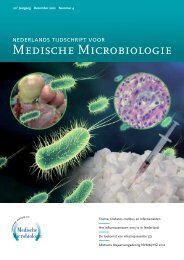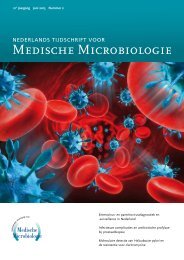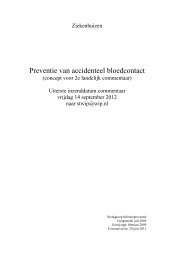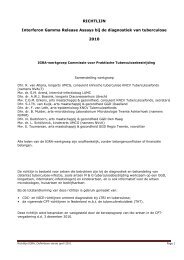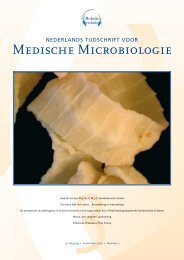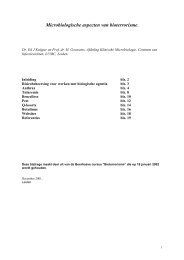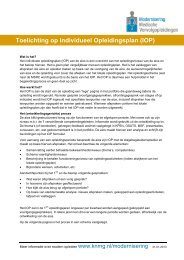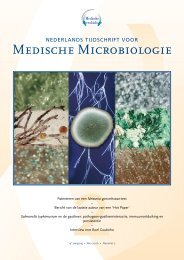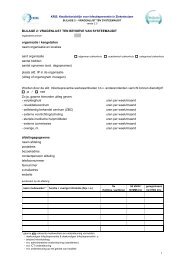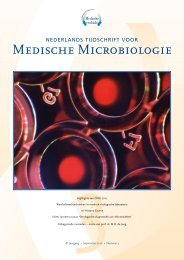Supplement bij veertiende jaargang, april 2006 - NVMM
Supplement bij veertiende jaargang, april 2006 - NVMM
Supplement bij veertiende jaargang, april 2006 - NVMM
Create successful ePaper yourself
Turn your PDF publications into a flip-book with our unique Google optimized e-Paper software.
06.08<br />
Fungal spores as survival capsules in time and space<br />
J. Dijksterhuis<br />
Applied and Industrial Mycology, Centraalbureau voor<br />
Schimmelcultures, Utrecht<br />
The variety of fungal spores is bewildering, but there main<br />
function is distribution. They can serve for propagation<br />
of the fungus from adverse locations towards better<br />
conditions. These spores often are produced in large<br />
numbers and are transported through air, water or by<br />
the action of living organisms. Spores also can serve for<br />
dispersion in ‘time’ by literally waiting for better times.<br />
These spores often have thick cell walls and are not<br />
dispersed. These spores show constitutive dormancy,<br />
that is a metabolic block that is released only after special<br />
triggers. Further, these spores can be highly resistant<br />
to many stressors and exhibit different very specialised<br />
features during dormancy and germination as in case<br />
of the fungus Talaromyces macrosporus. Communication<br />
between spores or spore compartments (in case of multicellular<br />
spores) may serve a fine-tuning of the rather<br />
stochastic process of distribution. Examples of such<br />
processes are discussed with the fungi Penicillium paneum<br />
and Fusarium culmorum. The apparatus of spore dispersal<br />
is highly specialised and may be prone to quick devaluation<br />
when not extensively used, as is discussed with the fungus<br />
Rhizopus oligosporus.<br />
06.09<br />
global regulation of survival strategies of the bacterial spore<br />
former Bacillus cereus<br />
T. Abee 1,2 , M. Tempelaars 1,2 , M. van der Voort 1,2 ,<br />
J. Wijman1,2 , W. van Schaik1,2 , M. Zwietering 1 , W. de Vos2 1<br />
Laboratory of Food Microbiology, Wageningen University,<br />
Wageningen, 2Wageningen Centre for Food Sciences,<br />
Wageningen<br />
Bacillus cereus is a common cause of food-borne disease<br />
that thrives in many different ecological niches. For the<br />
control of this pathogen, it is especially relevant to know<br />
which mechanisms it can utilize to sustain growth in<br />
the many environments that it can inhabit. We aimed to<br />
assess global regulation in B. cereus highlighting the role<br />
of a range of sigma factors, including the general stress<br />
sigma factor s B , the early sporulation sigma factor s H , and<br />
a number of selected extra-cytoplasmic-function (ECF)<br />
sigma factors, and the catabolite control protein CcpA in<br />
the performance of B. cereus under various growth and<br />
stress conditions, relevant in the processing and preservation<br />
of foods.<br />
Using B. cereus ATCC 14579 and targeted sigma factor- and<br />
ccpA-deletion mutants, the impact of these regulators and<br />
Ned Tijdschr Med Microbiol <strong>2006</strong>; 4:<strong>Supplement</strong><br />
S35<br />
their regulons on B. cereus growth performance, stress<br />
response, sporulation efficiency and surface behaviour,<br />
including swarming and biofilm formation, were assessed.<br />
In addition, proteomics and gene profiling, employing<br />
B. cereus whole genome ORF-based micro-arrays, are<br />
used to further identify key elements in B. cereus ecophysiology<br />
and virulence that may affect its performance<br />
and survival in industrial settings. This approach showed<br />
an involvement of s B in stress response, roles for s H and<br />
an ECF sigma factor in sporulation and biofilm formation,<br />
and regulatory roles of CcpA in key metabolic pathways,<br />
biofilm formation, and sporulation.<br />
06.10<br />
Mode-of-action of high pressure low temperature induced<br />
damage to Bacillus subtilis in the IceI-IceII domain<br />
T. Shen1,2 , A. Bos 2 , S. Brul 1,2<br />
1<br />
Swammerdam Institute for Life Science, Faculteit der<br />
Natuurwetenschappen, Wiskunde en Informatica, Amsterdam,<br />
2Unilever Food & Health Research Institute, Advanced Food<br />
Microbiology, Vlaardingen<br />
The damages on Bacillus subtilis vegetative cells induced<br />
by subzero temperatures and pressures up to 250MPa<br />
in buffer solution (i.e. in the area of IceI-IceIII phase<br />
transitions) was studied by means of flowcytometry in<br />
combination with membrane permeability and viability<br />
probes: PI (propidium iodide) and cFDA (carboxyfluorescein<br />
diacetate). The growth of single cells was traced<br />
by measuring the optical density and light scatter of the<br />
growth medium. Bacterial cells showed high heterogeneity<br />
in stress resistance to the treatment. Treated cells displayed<br />
a distribution into four populations characteristically<br />
by green (cFDA) and red (PI) fluorescent intensity: high<br />
green/low red; high green/high red; low green/high red;<br />
and low green/low red. Single cells from C in TSB (trypcase<br />
soy broth). Each population were sorted and incubated at 25<br />
Very few cells from the high red populations were found<br />
to grow after 50 days. A number of wells gated from the<br />
low red populations showed positive growth after 2.5-20<br />
days, while the lag time of untreated cells was only around<br />
0.7 day under the same growth condition. The lag time of<br />
the cells treated with different conditions does not differ<br />
significantly. Untreated cells sporulate immediately after<br />
reaching the maximum growth, which is less than 2 days’<br />
incubation. Finally, on the one hand, most cells treated<br />
by either freezing or HPLT generally show slower growth<br />
rate. These cells did not sporulate even 25 days after the<br />
onset of growth. On the other hand, cells sorted both from<br />
populations of high green/low red and low green/low red<br />
resulted in a similar number of positive wells and lag time.<br />
Conclusions: 1) Plasma membrane damage seemed to<br />
be the first mode-of-action of HPLT on the bacteria. 2)




